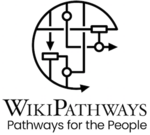Biology:WikiPathways
 | |
|---|---|
| Content | |
| Description | A wiki-based resource for collection, maintenance and distribution of biological pathways |
| Contact | |
| Primary citation | PMID 18651794 |
| Access | |
| Data format | GPML BioPAX |
| Website | http://www.wikipathways.org |
| Download URL | Pathways |
| Web service URL | REST |
| Sparql endpoint | http://sparql.wikipathways.org/sparql |
| Miscellaneous | |
| Software license | Creative Commons 0 |
| Data release frequency | monthly |
WikiPathways[1][2] is a community resource for contributing and maintaining content dedicated to biological pathways. Any registered WikiPathways user can contribute, and anybody can become a registered user.[3] Contributions are monitored by a group of admins, but the bulk of peer review, editorial curation, and maintenance is the responsibility of the user community. WikiPathways is originally built using MediaWiki software,[4] a custom graphical pathway editing tool (PathVisio[5]) and integrated BridgeDb[6] databases covering major gene, protein, and metabolite systems. WikiPathways was founded in 2008 by Thomas Kelder, Alex Pico, Martijn Van Iersel, Kristina Hanspers, Bruce Conklin and Chris Evelo. Current architects are Alex Pico and Martina Summer-Kutmon.
Pathway content
Each article at WikiPathways is dedicated to a particular pathway. Many types of molecular pathways are covered, including metabolic,[7] signaling, regulatory, etc. and the supported[8] species include human, mouse, zebrafish, fruit fly, C. elegans, yeast, rice and arabidopsis,[9] as well as bacteria and plant species. Using a search feature, one can locate a particular pathway by name, by the genes and proteins it contains, or by the text displayed in its description. The pathway collection can also be browsed with combinations of species names and ontology-based categories.
In addition to the pathway diagram, each pathway page also includes a description, bibliography, pathway version history and list of component genes and proteins with linkouts to public resources. For individual pathway nodes, users can access a list of other pathways with that node. Pathway changes can be monitored by displaying previous revisions or by viewing differences between specific revisions. Using the pathway history one can also revert to a previous revision of a pathway. Pathways can also be tagged with ontology terms from three major BioPortal ontologies (Pathway, Disease and Cell Type).
The pathway content at WikiPathways is freely available for download in several data and image formats. WikiPathways is completely open access and open source. All content is available under Creative Commons 0. All source code for WikiPathways and the PathVisio editor is available under the Apache License, Version 2.0.
Access and integration
In addition to various primary data formats (e.g. GPML, BioPAX, Reactome,[10] KEGG, and RDF[11]), WikiPathways supports a variety of ways to integrate and interact with pathway content. These include directed link-outs, image maps, RSS feeds and deep web services.[12] This enables reuse in projects like COVID19 Disease Map.[13]
WikiPathways content is used to annotate and cross-link Wikipedia articles covering various genes, proteins, metabolites and pathways. Here are a few examples:
- Citric acid cycle § Interactive pathway map
- Articles that link to Citric acid cycle template
See also
References
As of this edit, this article uses content from "WikiPathWays:About", which is licensed in a way that permits reuse under the Creative Commons Attribution-ShareAlike 3.0 Unported License, but not under the GFDL. All relevant terms must be followed.
- ↑ , Wikidata Q21092742
- ↑ , Wikidata Q24082733
- ↑ , Wikidata Q102205677
- ↑ Agrawal, Ayushi; Balcı, Hasan; Hanspers, Kristina; Coort, Susan L; Martens, Marvin; Slenter, Denise N; Ehrhart, Friederike; Digles, Daniela et al. (6 November 2023). "WikiPathways 2024: next generation pathway database". Nucleic Acids Research. doi:10.1093/nar/gkad960. PMID 37941138.
- ↑ , Wikidata Q21284199
- ↑ , Wikidata Q28842753
- ↑ Slenter, Denise N.; Kutmon, Martina; Hanspers, Kristina; Riutta, Anders; Windsor, Jacob; Nunes, Nuno; Mélius, Jonathan; Cirillo, Elisa et al. (10 November 2017). "WikiPathways: a multifaceted pathway database bridging metabolomics to other omics research". Nucleic Acids Research 46 (D1): D661–D667. doi:10.1093/NAR/GKX1064. PMID 29136241.
- ↑ "Browse pathways - WikiPathways". http://www.wikipathways.org//index.php?title=Special:BrowsePathwaysPage.
- ↑ Hanumappa, Mamatha; Preece, Justin; Elser, Justin; Nemeth, Denise; Bono, Gina; Wu, Kenny; Jaiswal, Pankaj (2013). "WikiPathways for plants: a community pathway curation portal and a case study in rice and arabidopsis seed development networks". Rice 6 (1): 14. doi:10.1186/1939-8433-6-14. PMID 24280312. Bibcode: 2013Rice....6...14H.
- ↑ Bohler, Anwesha; Wu, Guanming; Kutmon, Martina; Pradhana, Leontius Adhika; Coort, Susan L.; Hanspers, Kristina; Haw, Robin; Pico, Alexander R. et al. (20 May 2016). "Reactome from a WikiPathways Perspective". PLOS Computational Biology 12 (5): e1004941. doi:10.1371/journal.pcbi.1004941. PMID 27203685. Bibcode: 2016PLSCB..12E4941B.
- ↑ Waagmeester, Andra; Kutmon, Martina; Riutta, Anders; Miller, Ryan; Willighagen, Egon L.; Evelo, Chris T.; Pico, Alexander R. (23 June 2016). "Using the Semantic Web for Rapid Integration of WikiPathways with Other Biological Online Data Resources". PLOS Computational Biology 12 (6): e1004989. doi:10.1371/journal.pcbi.1004989. PMID 27336457. Bibcode: 2016PLSCB..12E4989W.
- ↑ Kelder, T.; Pico, A. R.; Hanspers, K.; Van Iersel, M. P.; Evelo, C.; Conklin, B. R.; Hide, W. (2009). Hide, Winston. ed. "Mining Biological Pathways Using WikiPathways Web Services". PLOS ONE 4 (7): e6447. doi:10.1371/journal.pone.0006447. PMID 19649250. Bibcode: 2009PLoSO...4.6447K.
- ↑ Ostaszewski, M. et al. (1 October 2021). "COVID19 Disease Map, a computational knowledge repository of virus–host interaction mechanisms". Molecular Systems Biology 17 (10): e10387. doi:10.15252/msb.202110387. PMID 34664389.
External links
 |

